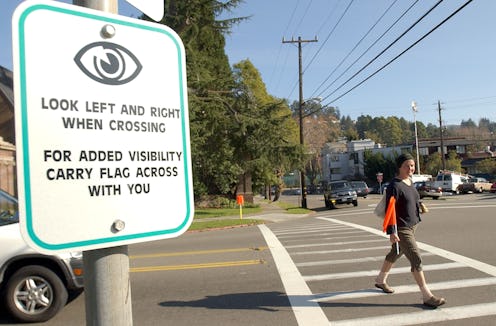News
Grab One, Save Lives?

In the ever evolving effort to keep the pedestrian safe, Bridgeport, Connecticut has implemented a new "pedestrian flag" program that has met with varying levels of success in other cities. The logic behind the flags seems solid enough: pedestrians are encouraged to carry flags when crossing streets in order to further identify themselves as car-less human bodies. Ideally, this program would reduce the number of pedestrian-car accidents, as drivers would be better able to see walkers if they were to wave little yellow flags.
If the idea seems a bit low-tech, it's because it's been around for nearly 20 years. First put into play in 1995 in Kirkland, Washington, pedestrian flags have been a mainstay at some crosswalks for years, and other cities, like Salt Lake City, Utah, have adopted the program since its debut. But for some cities, having flags didn't really make a difference when it came to traffic accidents, as evidenced by an unfortunate incident in Berkeley, California, in which a 53-year-old woman, carrying a flag, was struck by a Jeep just 48 hours after the program's implementation. Luckily, the woman was not seriously injured, but her accident did suggest that flag-carrying wasn't exactly a particularly effective safety precaution.
Other problems that have plagued the pedestrian flag program include rampant theft, purposeful or accidental, of the flags. Though they only cost 50 cents a piece, Berkeley ended the program after spending $10,000 to continuously replace flags "because of the high theft rate." Over the course of the three year program that ran from 2001 to 2004, the city was forced to purchase an astonishing 8,000 flags for only seven crossing sites.
After a review of the program, Berkeley found "that the flags were used as intended by only two percent of pedestrians, and the use of the flags did not have a noticeable effect upon driver behavior." Moreover, the city seemed to have a tough time getting residents to take the flags seriously, as "many of those who picked up the flags used them for purposes other than for which they were intended."
Ultimately, Berkeley decided to discontinue the program, concluding that the program was "not sustainable" because "the flags [were] misused and stolen," and that pedestrians would better benefit from learning "safe walking practices (e.g. bright, light colored clothes, defensive crossing techniques) while motorists [needed] to learn safe driving habits, watching for pedestrians at all times in all locations."
Of course, this is much easier said than done, as pedestrian accidents occur all too frequently, particularly in large metropolitan areas like New York City in which walking is a major mode of transportation. In 2013, the New York Police Department reported that 16,059 pedestrians and cyclists were injured, and 178 people were killed as a result of these types of traffic accidents. According to The Atlantic's City Lab, a pedestrian is killed in the U.S. every two hours as a result of a traffic accident, and while traffic fatalities as a whole have been on the decline, pedestrian accidents have actually increased since 2009.
Last year, after these findings were released, the Department of Transportation set aside $2 million for 22 cities that suffered from worse than average pedestrian fatality records. This money was meant to inject new life into education and enforcement initiatives, like the flag program, to reduce the rate of pedestrian accidents. One of the main programs the federal government has rolled out is the "Everyone Is A Pedestrian" campaign, which urges vigilance on the part of both pedestrians and automobile operators. As Transportation Secretary Anthony Foxx announced at a press event, "whether you drive a car, take the bus or ride a train, at some point in the day, everyone is a pedestrian."
The pedestrian flag program certainly appears to be a step in the right direction, and for now, Bridgeport has shelled out $500 to fund its pilot program. Bridgeport is not a city with particularly high rates of pedestrian accidents — six people have been killed since 2010 in pedestrian traffic incidents. But as Police Chief Joseph Gaudett said in a statement, the program “will be worth it if this project prevents one injury or death.”
And in some areas, the flags have met with positive results. In McCall, Idaho, for example, the program was first introduced in 2006, and is still in use today. According to the community development director, the flags encouraged some pedestrians, particularly families and the elderly, to be even more careful when crossing the street.